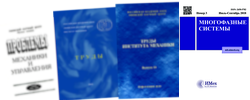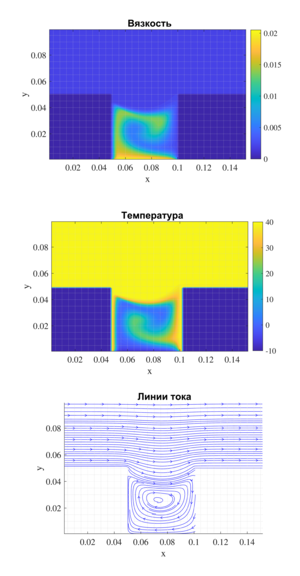

Modeling of fluid flow in channels with a cavity is relevant for solving engineering problems, for example, related to the design features of
devices associated, for example, with the processing and transportation of hydrocarbons, cooling systems. The presence of a cavity can
lead to the occurrence of local hydrodynamic effects, such as self-oscillations or other complex flow regimes. The influence of rheological
parameters of the fluid, heat exchange conditions and geometric parameters of the cavity and channel on the flow characteristics is
numerically studied. The mathematical model of the problem consists of continuity equations, modified Navier–Stokes equations taking into
account variable viscosity and energy conservation. To numerically solve these equations, the control volume method and the SIMPLE
algorithm modified to take into account the variable viscosity coefficient were used. To demonstrate the influence of various heat exchange
conditions on the flow character, a plate was located at the bottom of the cavity, on which a temperature was set that differed from the
ambient temperature. An experimental measurement of the viscosity of a 45% aqueous solution of propylene glycol was carried out in the
temperature range from −8 to 70 ◦C using a Thermo Scientific HAAKE MARS rotational rheometer of the Experimental Hydrodynamics
laboratory of the Institute of Mechanics of the Ufa Federal Research Center of the Russian Academy of Sciences. The results of numerical
modeling were compared with photographs of the experiment of creeping flow around a rectangular cavity for three cases with the ratio
of geometric parameters
thermoviscous liquid,
propylene glycol,
flat channel with a cavity
Modeling of fluid flow in channels with a cavity is relevant for solving engineering problems, for example, related
to the design features of devices associated, for example, with the processing and transportation of
hydrocarbons, cooling systems. The presence of a cavity can lead to the occurrence of local hydrodynamic effects, such as self-oscillations or other complex flow regimes. The influence of
rheological parameters of the fluid, heat exchange conditions and geometric parameters of the cavity and channel on the flow characteristics is numerically studied. The mathematical model
of the problem consists of continuity equations, modified Navier-Stokes equations taking into account variable viscosity and energy conservation. To numerically solve these equations,
the control volume method and the SIMPLE algorithm modified to take into account the variable viscosity coefficient were used. To demonstrate the influence of various heat exchange
conditions on the flow character, a plate was located at the bottom of the cavity, on which a temperature was set that differed from the ambient temperature. An experimental measurement
of the viscosity of a 45% aqueous solution of propylene glycol was performed in the temperature range from -8 to 70 °C using a Thermo Scientific HAAKE MARS rotational
rheometer of the Experimental Hydrodynamics laboratory of the Institute of Mechanics of the Ufa Federal Research Center of the Russian Academy of Sciences. The results of numerical
modeling were compared with photographs of the experiment of a creeping flow around a rectangular cavity for three cases with the ratio of geometric parameters







